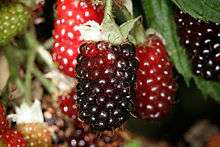Boysenberry
| Rubus ursinus × R. idaeus[1] | |
|---|---|
 | |
| Boysenberries in various stages of development | |
| Scientific classification | |
| Kingdom: | Plantae |
| (unranked): | Angiosperms |
| (unranked): | Eudicots |
| (unranked): | Rosids |
| Order: | Rosales |
| Family: | Rosaceae |
| Genus: | Rubus |
| Subgenus: | Rubus |
| Species: | R. ursinus × R. idaeus |
| Binomial name | |
| Rubus ursinus × R. idaeus | |
The boysenberry /ˈbɔɪzənbɛri/ is a cross among the European Raspberry (Rubus idaeus), a European blackberry (Rubus fruticosus), an American dewberry (Rubus aboriginum) and the Loganberry (Rubus × loganobaccus).[2]
It is a large 8.0-gram (0.28 oz) aggregate fruit, with large seeds and a deep maroon color,[3] which changes to the typical boysenberry color when the fruit is cooked and made into jam and pie.
History
The exact origins of the boysenberry are unclear, but the most definite records trace the plant as it is known today back to grower Rudolph Boysen, who may have obtained the dewberry/loganberry parent from the farm of a man by the name of John Lubben (who called it a "lubbenberry"), who in turn may have obtained it from Luther Burbank.[4]
In the late 1920s, George M. Darrow of the USDA began tracking down reports of a large, reddish-purple berry that had been grown on Boysen's Northern California farm.[5] Darrow enlisted the help of Walter Knott, a Southern California farmer who was known as a berry expert. Knott had never heard of the new berry, but he agreed to help Darrow in his search.
Darrow and Knott learned that Boysen had abandoned his growing experiments several years earlier and sold his farm. Undaunted by this news, Darrow and Knott headed out to Boysen's old farm, on which they found several frail vines surviving in a field choked with weeds. They transplanted the vines to Knott's farm in Buena Park, California, where he nurtured them back to fruit-bearing health. Walter Knott was the first to commercially cultivate the berry in Southern California.[5] He began selling the berries at his farm stand in 1932 and soon noticed that people kept returning to buy the large, tasty berries. When asked what they were called, Knott said, "Boysenberries," after their originator.[6] His family's small restaurant and pie business eventually grew into Knott's Berry Farm. As the berry's popularity grew, Mrs. Knott began making preserves, which ultimately made Knott's Berry Farm famous.
By 1940, 599 acres (242 ha) of land in California were dedicated to boysenberries; the number would trail off during World War II but peak again in the 1950s at about 2,400 acres, to the point where boysenberry crops exceeded those of the (previously) more common raspberry and blackberry. By the 1960s, the boysenberry began to fall out of favor due to a combination of being difficult to care for, susceptible to fungal diseases in coastal growing areas, and too soft and delicate to easily ship without damage, as well as having a short season of availability compared with newer cultivars. As of the early 2000s, fresh boysenberries are generally only grown for market by smaller farmers and sold from local farm stands and markets. Most commercially grown boysenberries, primarily from Oregon, are processed into other products such as jam, pie, juice, syrup, and ice cream. Since 2007, a hybrid variety called the "newberry" or "ruby boysen", developed to overcome some of the shortcomings that led to the boysenberry's decline in popularity, has been marketed through retailers in California and nearby states.[4]
New Zealand is the world’s largest producer and exporter of boysenberries.[7]
Characteristics
Boysenberries grow on low, trailing plants and are characterized by their soft texture, thin skins, and sweet-tart flavor. Mature fruits leak juice very easily and can start to decay within a few days of harvest.[4]
References
- ↑ "Boysenberry Characteristics" (PDF). Oregon Raspberry and Blackberry Commission. Archived from the original (PDF) on 2011-10-21. Retrieved 2008-09-13.
- ↑ Vaughan, John Griffith; C. A. Geissler (2009). The New Oxford Book of Food Plants. Oxford University Press. p. 88. ISBN 978-0-19-954946-7.
- ↑ "Oregon Boysenberries" (PDF). Archived from the original (PDF) on 2011-10-21. Retrieved 2008-09-13.
- 1 2 3 Karp, David (2010-05-27). "Boysenberry, a California treasure". Los Angeles Times. Retrieved 2013-09-01.
- 1 2 "Oregon Boysenberries". Archived from the original on 2011-10-21. Retrieved 2008-09-13.
- ↑ "Knott's Berry Farm's History". Archived from the original on 2009-07-20. Retrieved 2008-02-22.
- ↑ "Welcome to Berryfruit New Zealand". Berryfruit New Zealand. 2004. Retrieved 16 June 2016.
External links
 Media related to Boysenberries at Wikimedia Commons
Media related to Boysenberries at Wikimedia Commons